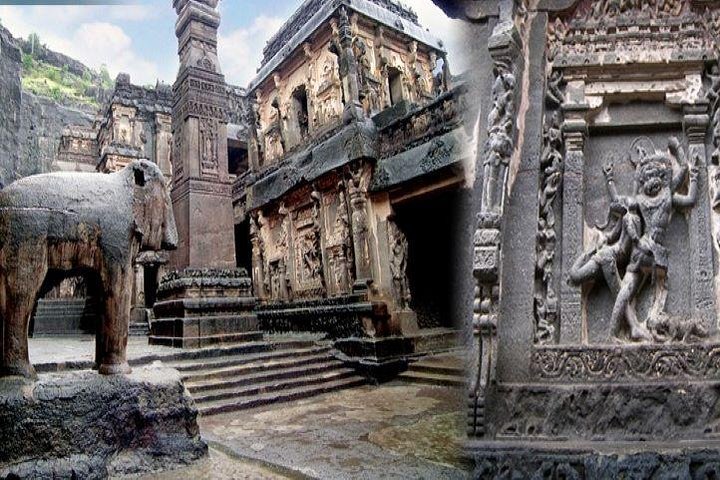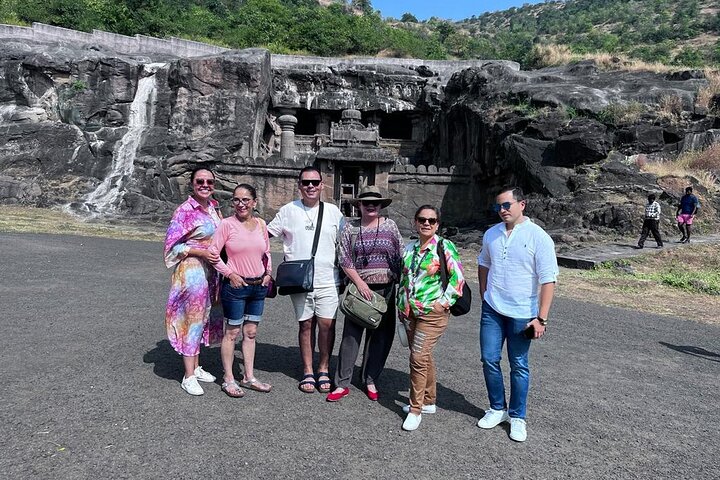Private Tour
Aurangabad Ajanta & Ellora Caves Same Day Tour
Overview
Available languages
Mobile ticket
Explore the mesmerizing heritage sites of the Ajanta and Ellora Caves.
The Ajanta Caves stand as a UNESCO World Heritage site, situated within Maharashtra, India. These caves have gained global acclaim for their ancient rock-cut Buddhist cave structures, with origins dating back to the 2nd century BCE. Revered for their architectural brilliance, they showcase awe-inspiring frescoes, sculptures, and rock-carved shrines that vividly portray the life and teachings of Lord Buddha.
Ellora Caves, an esteemed UNESCO World Heritage site nestled in Maharashtra, India, stand as an extraordinary ensemble of rock-cut temples and monasteries that pay tribute to India’s diverse cultural and religious legacy. These caves trace their origins to the 6th to 10th centuries CE and boast intricate sculptures, elaborate carvings, and captivating murals that vividly depict themes from Hinduism, Buddhism, and Jainism.
Additional Info
Public transportation options are available nearby
Infants are required to sit on an adult’s lap
Suitable for all physical fitness levels
Car Type: for one to two people, four seater Sedan.
Car Type: for three to four people, five Seater Innova.
Car Types: for five to eight people, twelve Seater Tempo traveller.
If pickup from outside city hotels / airport / railway station then it will be an additional charge, payable directly.
Cancellation Policy
For a full refund, cancel at least 24 hours before the scheduled departure time.
What‘s Included
2 Mineral Water (500 ml) per person
All Parking Fees, Tolls, Fuel & Taxes
English Speaking Guide
Entrance Fees of the Ajanta Caves & Ellora caves
Air-conditioned vehicle
Pick & Drop from the Aurangabad City Hotels Only.
Tips & Gratuties.
Any Accommodation
What To Expect
Ajanta Caves
Early morning, pick up from the hotel and proceed to visit Ajanta Caves The Ajanta caves are significant for their intricate rock-cut architecture. Stunning frescoes and cave paintings are considered some of the best examples of ancient Indian art. Ajanta caves are excavated in a horseshoe-shaped bend of rock surface nearly 76 m in height, overlooking the Waghur River. Built using only hammer and chisel, these caves served as secluded retreats for Buddhist monks for about nine centuries before being abruptly abandoned. These caves were rediscovered by an Army officer in the Madras Regiment of the British Army in 1819, during one of his hunting expeditions. Instantly, the discovery became very famous, and Ajanta became an important tourist destination in India. (Note: Closed on Monday)
Ellora Caves
Later, visit Ellora Caves. The caves at Ellora were carved out of the vertical face of the Charanandri hills between the 6th and 10th centuries AD. The carving work began around 550 AD. At the same time, the Ajanta caves were abandoned. Kailash Temple (cave 16), which is the most remarkable structure The Kailash Temple at Ellora was made by the Rashtrakuta dynasty as a temple for Lord Shiva. Perhaps it was meant to be a lookalike of Mount Kailash. The mystical abode of Shiva Kailash is a standalone, multi-storeyed temple complex made to look like Mount Kailash, the uranic home of Lord Shiva. Kailash Temple (cave 16) is the most remarkable structure of the cave group. Shaped by hand from a single massive rock, it includes a gateway, exhibition area, square hall, sanctum sanctorum, and tower that bear testimony to the excellence of Dravidian art. The Kailash Temple is a stupendous piece of architecture with spatial effects and grand sculptures. (Note: Closed on Tuesday)
Options
Car + Guide + Lunch
Lunch
Guide
Pickup included
Car + Guide
Guide
Pickup included
Reviews
2 reviews
Total reviews and rating from Viator & Tripadvisor
Amazing but.
Ronald E,
Nov 2, 2024
- Viator
5.00Caves are amazing but are 130 km apart so take a couple of hours to travel between and return to accomodation. Are on hills so lots of steps some steep
Ajantha and ellora
Sulatha D,
Oct 13, 2024
- Viator
5.00Excellent tour guide. Had an awesome time. The tour guide gave us a nice history and art experience.
Related Experiences
Operated by TOP TRAVEL AND TOURS PVT LTD.























